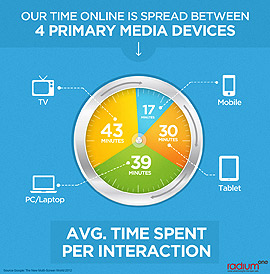Things get hectic quick
From the satellite dish to your joy stick
It's the night of the living cable box
Wires coming up from around the
block
Remote control to change the station
But that won’t change your situation
Have you seen what I mean
Remote I want
Control……
-- “Remote Control” by The Beastie Boys
The Beastie Boys were ahead of their time with their song “Remote
Control,” talking about the dissonance coming from a multitude of living room devices -- if they only knew how that dissonance would grow with multiple connected entertainment devices. If only
our daily lives were so simple as the remote from the cable box and the Xbox.
Recently, I attended the Multi-Screen Summit, a
two-day event about the confluence of the screens in our everyday lives and the impact on consumers and how brands are navigating between devices to reach their customers. It was great to see
entertainment brands, agencies and publishers thinking about how they need to design communication strategies to truly leverage the multi-screen environment in which we live. What was clear from the
Multi-Screen Summit is that entertainment brands are struggling to find their footing in a world where their consumers are always engaged, always distracted and always multi-tasking.
advertisement
advertisement
Entertainment brands, and all brands for that matter, must understand how their customers are spending their time across screens. To get a sense of how fragmented our daily multi-screen
use, take a look at the graphic below.

On average,
people are spending 17 minutes each day on their mobile devices (this number is expected to grow rapidly), 30 minutes on tablets, 39 minutes on desktop devices and 43 minutes in front of the TV. While
TV leads the way, I believe -- as did many marketers in the room -- that the number is a bit of a false positive. Here’s why. Over 75% of viewers say they are using another device while
“watching” TV. If you thought time-shifted watching was bad, it’s now even worse given these new data. Your 30-second pods get reach (measured) but are people really engaging? Some
smart brands say yes -- because they understand the shift and have created entry points that engage multitasking users.
Concrete examples of marketers that get it -- Toyota,
Progressive Insurance and NBC. Each of these brands has tested using Shazam as an overlay in their broadcast creative to engage their multi-screen multi-taskers and deliver some type of value (e.g.,
contest, coupons, expanded content, etc.). Is it working? It may be, but you will have to ask the brands. From my conversations with friends on the brand side, I gather it’s working pretty well
as a test. Remember that, for big brands, they need scale, and this is not a full-blown strategy, it’s a tactic.
My point here is that these brands are smart to jump in now,
experiment at a discounted rate (the market isn’t mature) and test, test, test. The Shazam test may work and it may fail, but they won’t fail for experimenting and will be miles ahead of
other brands sitting on the sidelines debating about the perfect strategy and tactics to deploy. Multi-screeners’ behaviors will dodge and weave like a flock of birds, brands that are nimble
enough to test and adapt to a fast-changing, multi-screen world will reap the rewards and gain valuable insights along the way while others are baffled by the rapid shifts of the multi-screener
flock.
The brands and Shazam are just one example that comes to mind as I write. There are certainly other examples, and I encourage you to send your thoughts and post
comments on this article. Shazam is not the only answer, but it is an answer. The fact is that I like Shazam, and I think the utility value of the app is killer and sticky.
In
the immortal words of Mike D from the Beastie Boys, “Things get hectic fast.” Does your brand or agency have a plan to put your remote in control?